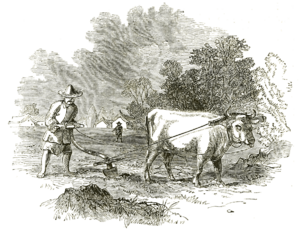Pre-industrial society facts for kids
A pre-industrial society is what life was like before the Industrial Revolution. This big change happened between 1750 and 1850. Before this time, people didn't have many machines or factories to help them make things quickly. Instead, most work was done by hand or with simple tools.
These societies existed for thousands of years. But when we talk about "pre-industrial society," we usually mean the time right before the Industrial Revolution began. How these societies worked could be very different from place to place. For example, in Europe, there was often a system called feudalism, where lords owned land and peasants worked it. The Italian Renaissance was also a famous time in pre-industrial Europe, bringing new art and ideas.
The term "pre-industrial" is also used when talking about the environment. For instance, the Paris Agreement on Climate Change (a big plan to help our planet) talks about keeping global warming below 1.5 degrees Celsius compared to "pre-industrial" levels. This means they are comparing today's temperatures to how warm it was before factories and industries started changing the climate.
How Life Was Different
Life in a pre-industrial society was very different from today. Here are some common things you would find:
- Limited Production: Not many things were made quickly or in large amounts. Most items were crafted by hand.
- Farming Life: The economy was mostly about farming. Most people were farmers, growing food for themselves and their communities.
- Few Different Jobs: People didn't have as many different jobs as we do today. Most people did similar tasks, like farming or simple crafts.
- Simple Social Groups: There weren't many different social classes. Often, there were just a few main groups, like farmers (peasants) and landowners (lords).
- Small Worlds: People usually didn't travel far from their homes. News and ideas spread slowly, so most people only knew about their own village or nearby areas.
- Growing Populations: Populations slowly grew over time, but not as fast as they would after the Industrial Revolution.
- Living Off the Land: People often lived at a "subsistence level." This means they grew or made just enough to survive, with little extra.
- Everyone Needed Farmers: The whole community relied on farmers to produce enough food for everyone to eat.
- Village Life: Most people lived in small villages or on farms, not in big cities like today.
Economic Systems
Different ways of organizing how people made and traded things existed in pre-industrial times:
- Hunter-Gatherers: Some societies lived by hunting animals and gathering plants, moving from place to place.
- Subsistence Farming: Many people grew just enough food for their families to eat.
- Simple Trade: People traded goods they produced, like food or crafts, with others.
- Mercantilism: This was an economic idea where countries tried to get rich by controlling trade and collecting gold and silver.
Working Conditions
Working conditions in pre-industrial times were often tough. People worked long hours, and there were no laws to protect workers. Things like child labour (children working) were common. Living conditions could also be dirty and unhealthy. These harsh conditions were a normal part of life long before the Industrial Revolution began.
See also
- Agrarian society
- Industrialisation
- Traditional society
- Hunter gatherers
- Nomads
- Post-industrial society


